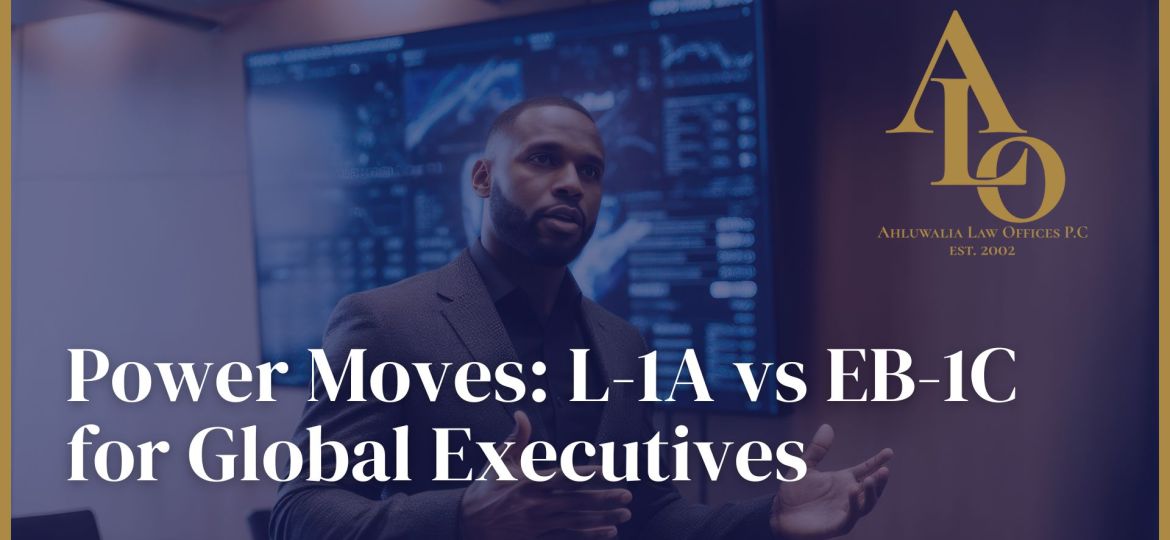
For multinational executives and managers, expanding operations to the United States often starts with a pivotal question — should you apply for an L-1A visa or an EB-1C green card? Both categories are designed for leaders who drive international growth, but they serve different timelines, eligibility frameworks, and long-term goals. Understanding these distinctions can help your organization — and its leadership — choose the right path forward.
The L-1A Intracompany Transferee Visa: A Temporary Leadership Bridge
The L-1A visa, as outlined by U.S. Citizenship and Immigration Services (USCIS), allows a U.S. employer to transfer an executive or manager from one of its affiliated foreign offices to the United States. It can also be used to send an executive or manager to open a new U.S. office.
Key Eligibility Requirements:
- The foreign employee must have worked abroad for the qualifying organization for at least one continuous year within the past three years.
- The U.S. employer must have a qualifying relationship (parent, subsidiary, affiliate, or branch) with the foreign entity.
- The position in the U.S. must be executive or managerial in nature.
Duration and Benefits:
- Initial stay: 3 years (1 year for new offices), renewable for up to 7 years total.
- Dual intent: L-1A holders can apply for a green card without jeopardizing their visa status.
- Ideal for: Executives expanding or managing U.S. operations who may later consider permanent residency.
The EB-1C Green Card: Permanent Residence for Multinational Managers and Executives
The EB-1C immigrant classification is a permanent visa option for managers and executives of multinational companies. Unlike the L-1A, this is an employment-based green card category — no temporary visa step is required.
Key Eligibility Requirements:
- The foreign national must have been employed outside the U.S. for at least one year in a managerial or executive role during the three years preceding the petition (or before entry as a nonimmigrant).
- The U.S. petitioner must have been doing business for at least one year and have a qualifying relationship with the foreign entity.
- The offered position must be managerial or executive, mirroring the overseas role.
Advantages:
- No labor certification (PERM) required.
- Direct path to permanent residency.
- Recognizes international business leadership as a contribution of national importance.
Considerations:
- Processing times may vary based on visa bulletin backlogs and country of chargeability.
- Applicants must prove the U.S. business is operational and capable of supporting the executive role.
Comparing the Two: L-1A vs EB-1C
| Feature | L-1A Visa | EB-1C Green Card |
|---|---|---|
| Type | Nonimmigrant (Temporary) | Immigrant (Permanent) |
| Purpose | Transfer executives/managers to U.S. entity | Grant permanent residence to executives/managers |
| Duration | Up to 7 years | Permanent |
| Labor Certification | Not required | Not required |
| Business Operations | U.S. entity can be newly established | Must be operating for at least 1 year |
| Best For | Companies testing or expanding into U.S. markets | Established companies seeking permanent U.S. leadership presence |
Which Option Is Right for You?
- Choose L-1A if your company is expanding into the U.S. or you need a temporary executive transfer to oversee growth.
- Choose EB-1C if your company already has a solid U.S. presence and you’re ready to secure permanent residence for top management.
Both routes honor leadership as a critical component of global enterprise — the right choice depends on where your business stands today and where it aims to grow tomorrow.
Guidance from Ahluwalia Law Offices
At Ahluwalia Law Offices, we help multinational businesses and their executives identify the most strategic visa pathway for their long-term goals. Whether it’s establishing a U.S. subsidiary through an L-1A or securing a permanent foothold through EB-1C, our team ensures every detail meets USCIS requirements and business compliance standards.


